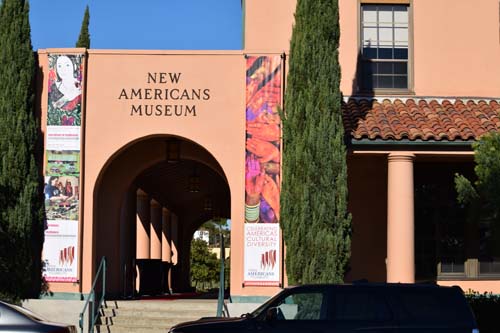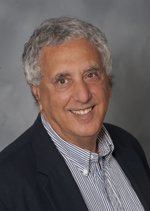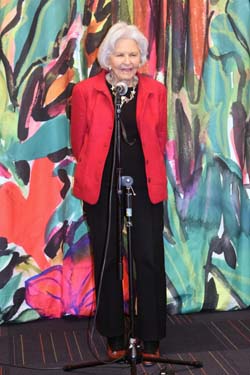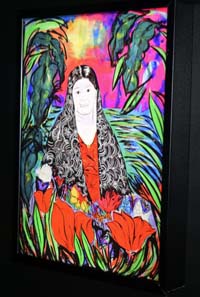
By Donald H. Harrison


SAN DIEGO—Nonagenarian Deborah Szekely has succeeded at many enterprises, most notably as a visionary behind the Rancho La Puerta spa and resort in Tecate, Mexico, and the Golden Door spas that even found their way onto cruise ships. In 2010, she experienced what seemed like a failure when the New Americans Museum closed at San Diego’s Liberty Station as the civilianized Naval Training Center now is known.
Failure, however, is not in Szekely’s personal vocabulary, and on Friday, Jan. 16, she announced at a news conference the reopening—or as she put it, the “reawakening”—of the New Americans Museum. As she did so, she stood in front of a wall entirely covered by a digitized image created by Los Angeles artist Carolyn Castaño invoking the bright colors of a Colombian rain forest, part of the reopened museum’s initial look at the places from which New Americans come.

Other images in the exhibition of Castaño’s works portrayed the impacts of warfare on indigenous people, the works quoting from better-known images. For example in one striking light box piece, with an effect similar to a stained glass window, there is a portrait of a woman whose son died in the conflict. If only she could have held him one last time. Castaño pictured her amid the the tropical flora and imagining herself holding her dead son’s body as the Virgin Mary does in Michelangelo’s Pieta.
I asked Szekely, who is Jewish, about her own immigration experience, and she said that her father left what is today Poland to avoid being drafted into the Russian army for a lifetime of slave-like conditions. It was a familiar immigration story of the 20th century, she said. Was her museum here on the West Coast inspired by the Ellis Island Museum in New York City’s harbor? No, she responded, as nice a museum as Ellis Island is—that is a “museum of the past” whereas the New Americans Museum is a museum celebrating the present and the future.
What is it exactly that she wants people to take away from a visit to the museum? I asked her as we stood near some indigenous weavings of Colombian life collected by Szekely obtained between 1984 and 1991 while she served as president of the Inter-American Foundation. Descriptions of the collection were written by Patrick Breslin.
With some passion, she asked me to imagine a child whose immigrant parents are working at low-paying, menial jobs. The child feels mired in poverty, especially as he looks at what other children have, and he feels that he and his parents must be stupid. The child cannot imagine the difference between what his parents have now – tools for their jobs, a home of their own with running water and a refrigerator—and the utter poverty that they escaped when they left their native village. The child does not know that people in that village had no tools of their own, but had to share them; and did not have a steady supply of electricity for their homes, much less a working refrigerator.
People who live under such conditions can’t afford on their own to immigrate to the United States; they get here with the help of their fellow villagers, who recognize the immigrants have special qualities that will help them to succeed in the United States, said Szekely. Children of immigrants who come to the museum will learn and take pride in how far their families have come, in a material sense, and also learn about the beauty, the art, and the music that they brought with them to America, helping to further enrich a well-off country.
Szekely told the news conference that the museum will help to sponsor ceremonies for children recreating the oath-taking that their parents went through when they became citizens, to help the children comprehend the enormity of the process.
Leticia Gomez Franco, the museum’s director of programs, said that the museum will host four exhibits a year, each dealing with a place of origin of immigrants, or a theme that illustrates the process of becoming Americanized. Overall, the museum will seek to depict the diversity of America’s immigrants and the great value that diversity has for America.
In April, for example, the next exhibition will be one that had been at the National Museum of American Jewish History in Philadelphia examining how baseball—especially the love for it—has aided various immigrant groups in the naturalization process.
A fact sheet said New Americans Museum programming will focus on post World War II immigrant histories, with docent and school tours. Featured artists such as Castaño will give talks; there will be forums, and “Emerging Arts Leaders” internship programs. The museum at 2825 Dewey Road will be open Tuesdays through Sundays, from 10 a.m. to 4 p.m. weekdays and 11 a.m. to 3 p.m. weekends.
*
Harrison is editor of San Diego Jewish World. Your comment may be posted in the space provided below or sent directly to the author at donald.harrrison@sdjewishworld.com
Pingback: Latest Immigration Training News - IDmap
What a well written article.
Wonderful article. I was not familiar with Deborah Szekely or the museum but I will make a point of visiting. I am thrilled the baseball exhibit from the National Museum of American Jewish History in Philadelphia is coming here. I am a member of that museum and am a baseball fan. I was very much aware of the exhibit there and am looking forward to seeing it here in San Diego.